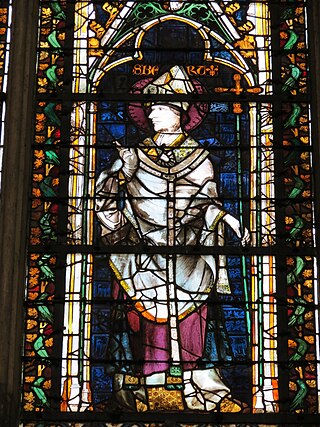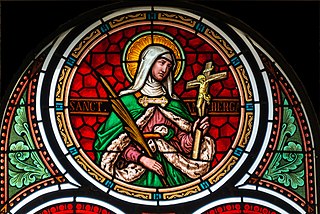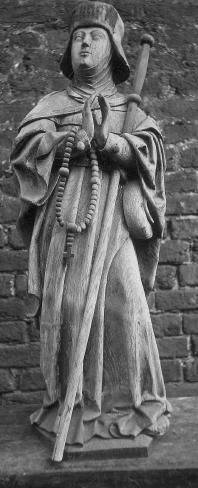Related Research Articles

Canonization is the declaration of a deceased person as an officially recognized saint, specifically, the official act of a Christian communion declaring a person worthy of public veneration and entering their name in the canon catalogue of saints, or authorized list of that communion's recognized saints.

Gudula of Brabant, also known as Saint Gudula, was a Christian saint who is venerated in Catholic and Orthodox churches. In Brabant, she is usually called Goedele or Goule;. Her name is connected to several places: Moorsel, Brussels and Eibingen.

August 4 - Eastern Orthodox liturgical calendar - August 6

August 10 - Eastern Orthodox liturgical calendar - August 12

The Archdiocese of Cambrai is a Latin Church ecclesiastical jurisdiction or archdiocese of the Catholic Church in France, comprising the arrondissements of Avesnes-sur-Helpe, Cambrai, Douai, and Valenciennes within the département of Nord, in the region of Nord-Pas-de-Calais. The current archbishop is Vincent Dollmann, appointed in August 2018. Since 2008 the archdiocese has been a suffragan of the Archdiocese of Lille.

Simeon at the Temple is the "just and devout" man of Jerusalem who, according to Luke 2:25–35, met Mary, Joseph, and Jesus as they entered the Temple to fulfill the requirements of the Law of Moses on the 40th day from Jesus' birth, i.e. the presentation of Jesus at the Temple.

Ghislain was a confessor and anchorite in Belgium. He died at the town named after him, Saint-Ghislain.

Ansbert, sometimes called Ansbert of Chaussy, was a Frankish monk, abbot and bishop of Rouen, today regarded as a saint in the Catholic Church and Eastern Orthodox Church.

Vedast or Vedastus, also known as Saint Vaast or Saint Waast, Saint Gaston in French, and Foster in English was an early bishop in the Frankish realm. After the victory of Tolbiac Vedast helped instruct the Frankish king Clovis in the Christian faith of his wife, Queen Clotilde.

The Abbey of St Vaast was a Benedictine monastery situated in Arras, département of Pas-de-Calais, France.

Saint Amalberga of Maubeuge was a Merovingian nun and saint who lived in the 7th century.

Reineldis was a saint of the 7th century, martyred by the Huns.

Saint Gaugericus, in French Saint Géry was a bishop of Cambrai, France.

Saint Lietbertus of Brakel was bishop of Cambrai from 31 March 1051 to 28 September 1076. Liebertus was born to the Brabantian nobility at Opbrakel. He served as archdeacon and provost of the cathedral of Cambrai before his election as bishop.

The Diocese of Arras (–Boulogne–Saint-Omer) is a Latin Church diocese of the Catholic Church in France. The episcopal see is the Arras Cathedral, in the city of Arras. The diocese encompasses all of the Department of Pas-de-Calais, in the Region of Hauts-de-France.
Ælfgifu of Shaftesbury was the first wife of King Edmund I. She was Queen of the English from her marriage in around 939 until her death in 944. Ælfgifu and Edmund were the parents of two future English kings, Eadwig and Edgar. Like her mother Wynflaed, Ælfgifu had a close and special if unknown connection with the royal nunnery of Shaftesbury (Dorset), founded by King Alfred, where she was buried and soon revered as a saint. According to a pre-Conquest tradition from Winchester, her feast day is 18 May.
Gerard of Florennes, bishop of Cambrai as Gerard I, had formerly been chaplain to Henry II, Holy Roman Emperor, and helpful to the latter in his political negotiations with Robert the Pious, King of France. In 1024 Gerard called a synod in Arras to confront a purported heresy fomented by the Gundulfian heretics, who denied the efficacy of the Eucharist. The records of this synod, the Acta Synodi Atrebatensis, preserve a summary of orthodox Christian doctrine of the early eleventh century, as well contemporary peace-making practices. According to this text's author, the heretics were convinced by Gerard's explanation of orthodoxy, renounced their heresy, and were reconciled with the church.
Gerard II, sometimes Gerard of Lessines, was the thirty-third bishop of Cambrai from 1076 and the last who was also bishop of Arras. He was a prince-bishop of the Holy Roman Empire, and his episcopacy coincided with the beginning of the Investiture Controversy between emperor and pope.
The Deeds of the Bishops of Cambrai is an anonymous Latin history of the diocese of Cambrai. It was commissioned around 1024 by Bishop Gerard I of Cambrai and completed shortly after his death in 1051. It is the work of two authors.

Aubert of Cambrai or Aubertus was a Merovingian Bishop of Cambrai and Arras and a Frankish saint.
References
- 1 2 Dr John Hutchison Hall website, Saints
- ↑ Gutenberg website, The Lives of the Saints by Rev S Baring-Gould, page 116
- ↑ USC Libraries website
- ↑ Santosepulcro website, St Emebert
- ↑ Walsh, Michael. A New Dictionary of Saints, Liturgical Press, 2007, p. 177 ISBN 9780814631867
- ↑ Katholic Norway website, Saint Emebert of Cambrai-Arras
- ↑ Nominis website Ablebert
- ↑ Odden, Per Einar. Den hellige Emebert av Cambrai-Arras, Den katolske kirke, July 19, 2006
- ↑ "15 Janvier: Saints Adolphe, Emebert et Vindicien". Diocèse de Cambrai (in French).
- ↑ Celtic Orthodox Faith website, Liturgical Calendar Part 2